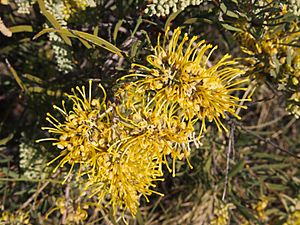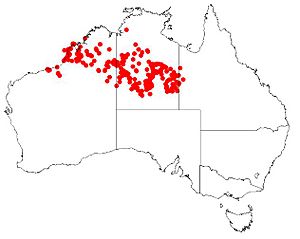Flat-leaved hakea facts for kids
Quick facts for kids Dogwood hakea |
|
|---|---|
 |
|
| Scientific classification | |
| Genus: |
Hakea
|
| Species: |
macrocarpa
|
 |
|
| Occurrence data from AVH | |
Hakea macrocarpa, often called dogwood hakea, is a cool shrub or tree. It belongs to the Proteaceae plant family. This plant grows pretty cream-yellow flowers. You can usually see them from May to June. It's special because it's only found in Western Australia. This means it is "endemic" to that area.
Contents
What Does Dogwood Hakea Look Like?
This tall, slender shrub or tree can grow quite big. It usually reaches a height of about 1 to 6 metres (3 to 20 feet). Its trunk and branches have bark that is black-brown and looks like it has grooves or furrows. If the plant gets damaged, it can grow back from its base.
Leaves and Flowers
The smaller branches are covered in soft, matted hair. The part of the leaf that connects to the stem, called the petiole, is short. It's only about 1 to 5 millimetres long. The main part of the leaf, called the lamina, is long and narrow. It can be 5 to 35 centimetres (2 to 14 inches) long and 3 to 15 millimetres (0.1 to 0.6 inches) wide.
The dogwood hakea blooms from May to October. It produces flowers that are cream, green, or yellow. Each flower cluster, known as an inflorescence, has many flowers. There can be anywhere from 40 to 200 cream-yellow flowers in one cluster. Each flower has a special outer part called a perianth, which is 7 to 15 millimetres long.
Fruit and Seeds
After the flowers bloom, the plant forms interesting fruits. These fruits have a curved, beak-like shape. They are about 22 to 40 millimetres (0.9 to 1.6 inches) long. Inside these fruits are seeds. The seeds are quite large, measuring 18 to 37 millimetres (0.7 to 1.5 inches) long. They are also 9 to 14 millimetres (0.4 to 0.6 inches) wide. Each seed has a wing that covers about half of one side. This wing helps the seeds spread.
How Dogwood Hakea Got Its Name
The dogwood hakea was first officially described by a botanist named Robert Brown. He wrote about it in his book Proteaceas Novas. The plant's scientific name, Hakea macrocarpa, has a special meaning. The second part of the name, "macrocarpa," comes from two ancient Greek words. "Makros" (μακρός) means "long," and "karpos" (καρπός) means "fruit." So, Hakea macrocarpa basically means "long-fruited hakea," which makes sense because of its long fruits!
Where Dogwood Hakea Lives
This plant is found in specific parts of Australia. It is "endemic" to certain areas. You can find it scattered across the central Northern Territory. It also grows in the Kimberley, Pilbara, and Goldfields-Esperance regions of Western Australia.
The dogwood hakea likes to grow in sandy places. You can often spot it among coastal sand dunes. It also thrives on sandplains and around rocky ridges. It prefers to grow in red sandy soils.

